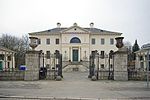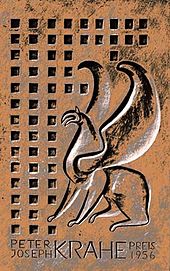Peter Joseph Krahe

Peter Joseph Krahe (born April 8, 1758 in Mannheim ; † October 7, 1840 in Braunschweig ) was a German architect of early classicism . Krahe was significantly involved in the redesign of the Braunschweig ramparts .
Life
The son of the history painter Lambert Krahe (1712–1790) studied painting from 1775 onwards at the Düsseldorf Art Academy founded by his father in 1773 . There, in 1780, the only twenty-two-year-old was appointed professor of the “architecture class”. Various designs have come down to us from Krahe's time in Düsseldorf, for an extensive palace complex, for stables, theaters, churches and private houses, which, in addition to being close to Peter Anton von Verschaffelt, already indicate “an independent and mature architect”. In 1782 he went on a study trip to Rome , which was made possible by a grant from Elector Karl Theodor of Palatinate-Bavaria . After returning in 1783, Krahe switched to the profession of architect. A second stay in Italy followed in 1785 and 1786, during which time he was appointed honorary professor at the Academy of Arts in Florence . Krahe's first building project was the Koblenz Theater , which was completed in 1787 and commissioned by Elector Clemens Wenzeslaus of Saxony . In 1790 he was appointed court chamber councilor and building director for the Electorate of Trier in Koblenz. As a result of the French occupation , the building management was dissolved in 1795. Until 1802 it was mentioned in connection with the erection of two monuments to French revolutionary generals and a town house. Krahe applied as the first architect to the electoral court in Hanover , which was dissolved in 1803 as a result of the Second Coalition War ; therefore there was probably no employment.
Activity in Braunschweig
Duke Karl Wilhelm Ferdinand von Braunschweig personally campaigned, presumably through the mediation of the publisher Vieweg, for Krahe to move to his royal seat. On November 21, 1803 he began his work as a chamber and monastery councilor and head of construction in the Duchy of Braunschweig as the successor to Christian Gottlob Langwagens .
Krahe retired in 1837. His successor as court building officer was Carl Theodor Ottmer . Krahe died in Braunschweig in 1840 and was buried in the Catholic cemetery on Hochstrasse in Braunschweig. In 1972 the grave was reburied and the tombstone moved from Hochstrasse to Magnifriedhof on Ottmerstrasse, the resting place of several important Brunswick personalities. His son Friedrich Maria Krahe (1804–1888) was also an important architect who worked in Braunschweig.
plant
Krahe created a design for the synagogue on Kasernenstrasse in Düsseldorf around 1790 , which was implemented in a modified form. In Braunschweig , the Doric portico of the Augusttorwache was built between 1804 and 1807 and was set up in the Bürgerpark in 1896 . The classicist villa “ Salve Hospes ” was built between 1805 and 1808 for the merchant Diedrich Wilhelm Krause. The most important achievement of Krahe was the razing of the fortifications, begun in 1803, and the erection of the ramparts. The classicist gatehouses on the ramparts were built between 1804 and 1821. The riding house on Langedammstrasse was built in 1823. In the same year, the iron obelisk was inaugurated on the monumental plaza on Löwenwall designed by Krahe, until 1904 "Monumentplatz". The Villa Amsberg was built in 1827.
Retrospective (selection from Braunschweig)
Torhaus Helmstedter Straße, today the Museum of Photography
The Gaussberg
Retrospective (selection from other locations)
Koblenz Theater (1787)
The Marceau Monument in Koblenz (1797)
General Hoche Monument in Weißenthurm am Rhein (1798)
Former barracks in the Electorate of Trier, today town hall of the community of Niederselters
Old Synagogue Düsseldorf (1792)
Commemoration
The Peter-Joseph-Krahe-Strasse in Braunschweig and the architecture prize of the city of Braunschweig were named after Krahe.
Peter Joseph Krahe Prize
In 1954, the city of Braunschweig donated the architecture prize, which was first awarded in 1956 and then awarded twelve times, "in recognition and to promote architectural achievements in the city of Braunschweig and in memory of the master builder Peter Joseph Krahe". The last award ceremony took place in 2009. The building owner and architect are honored together. The prize consists of a certificate and a bronze plaque, designed by artists from Braunschweig.
literature
- Gerd Biegel , Harmen H. Thies (Ed.): Peter Joseph Krahe. Contributions to the architecture of classicism in Braunschweig. (Braunschweig Contributions to Cultural History), Frankfurt a. M. 2015, ISBN 978-3-631-64407-2 .
-
Reinhard Dorn : Peter Joseph Krahe. :
- Volume 1: Years of study in Düsseldorf and Rome 1178–1786. Braunschweig 1969.
- Volume 2: Buildings and projects in Düsseldorf, Koblenz, Hanover and Braunschweig 1787–1806. Braunschweig 1971.
- Volume 3: Buildings and projects in the Kingdom of Westphalia and the Duchy of Braunschweig 1808–1837. Edited by Elisabeth Spitzbart. Deutscher Kunstverlag, Munich, Berlin, 1999.
- Reinhard Dorn: Krahe, Peter Joseph. In: New German Biography (NDB). Volume 12, Duncker & Humblot, Berlin 1980, ISBN 3-428-00193-1 , p. 658 f. ( Digitized version ).
- Peter Giesau: Krahe, Peter Joseph. In: Luitgard Camerer , Manfred Garzmann , Wolf-Dieter Schuegraf (eds.): Braunschweiger Stadtlexikon . Joh. Heinr. Meyer Verlag, Braunschweig 1992, ISBN 3-926701-14-5 , p. 133-34 .
- Jürgen Hodemacher : Braunschweig's streets - their names and their stories. Volume 2: Between Okergraben and the city ring. Cremlingen 1996.
- Cecilie Hollberg (Ed.): Peter Joseph Krahe. An architect around 1800. Exhibition catalog, Städtisches Museum Braunschweig, Braunschweig 2015, ISBN 978-3-927288-38-6 .
- Horst-Rüdiger Jarck , Günter Scheel (Ed.): Braunschweigisches Biographisches Lexikon - 19th and 20th centuries . Hahnsche Buchhandlung, Hannover 1996, ISBN 3-7752-5838-8 , p. 343-44 .
- Ulrich Knufinke, Simon Paulus (Ed.): Peter Joseph Krahe. Guide to classicism in Braunschweig and the surrounding area. Braunschweig 2008.
Web links
- Literature by and about Peter Joseph Krahe in the catalog of the German National Library
Individual evidence
- ^ Richard Klapheck : Architecture and Art Academy , Düsseldorf 1919, p. 210 ( file in PDF )
- ^ Peter Joseph Krahe Prize. City of Braunschweig, accessed April 4, 2010 .
- ↑ Information brochure on the Peter Joseph Krahe Prize. (PDF; 780 kB) City of Braunschweig, accessed on April 4, 2010 .
| personal data | |
|---|---|
| SURNAME | Krahe, Peter Joseph |
| BRIEF DESCRIPTION | German architect |
| DATE OF BIRTH | April 8, 1758 |
| PLACE OF BIRTH | Mannheim |
| DATE OF DEATH | October 7, 1840 |
| Place of death | Braunschweig |











